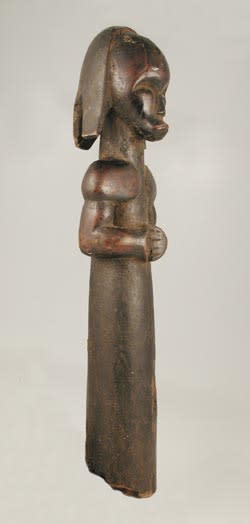Fang Byeri Sculpture, 20th Century CE
Wood
height 50.2 cm
height 19 3/4 in
height 19 3/4 in
PF.6122
Further images
The Fang people migrated from the northwest during the 18th and 19th centuries and are today spread out across southern Cameroon, Equatorial Guinea, and Gabon. They are primarily hunters but...
The Fang people migrated from the northwest during the 18th and 19th centuries and are today spread out across southern Cameroon, Equatorial Guinea, and Gabon. They are primarily hunters but farm as well. Fang social structure is based upon the clan, a group of individuals with a common ancestor, and upon the family. They also maintain tribal cohesion through the So and Ngil societies. Each family possessed a Byeri, or reliquary box, in which the bones of famous ancestors were kept. The box was kept by the Esa, the eldest man in the family.
Fang Byeri figures (the guardian statue that surmounts the Byeri box) are usually characterized by male figures. Although they are generally depicted seated, they sometimes are represented emerging from a columnar staff, such as this example, without the suggestion of a lower body. Their hands are usually joined around the stomach and their highly stylized heads may feature inlaid metal eyes. While this figure is devoid of metallic adornments, his gaze is as equally captivating. In this case, the figure holds his muscular arms close to his side, resting his hands alongside his stomach. Sometimes similar sculptures hold magical divination devices in their hands in order to conjure up spiritual forces. However, this powerful figure needs no tools, for he is able to communicate with the beyond solely with his hypnotic stare. This guardian clearly commands a forceful presence in the mysterious realm of the other world. He functions both as guardians of the spirits of deceased ancestors as well as the protector of our health and benevolence that are influenced by forces from beyond.
Fang Byeri figures (the guardian statue that surmounts the Byeri box) are usually characterized by male figures. Although they are generally depicted seated, they sometimes are represented emerging from a columnar staff, such as this example, without the suggestion of a lower body. Their hands are usually joined around the stomach and their highly stylized heads may feature inlaid metal eyes. While this figure is devoid of metallic adornments, his gaze is as equally captivating. In this case, the figure holds his muscular arms close to his side, resting his hands alongside his stomach. Sometimes similar sculptures hold magical divination devices in their hands in order to conjure up spiritual forces. However, this powerful figure needs no tools, for he is able to communicate with the beyond solely with his hypnotic stare. This guardian clearly commands a forceful presence in the mysterious realm of the other world. He functions both as guardians of the spirits of deceased ancestors as well as the protector of our health and benevolence that are influenced by forces from beyond.







